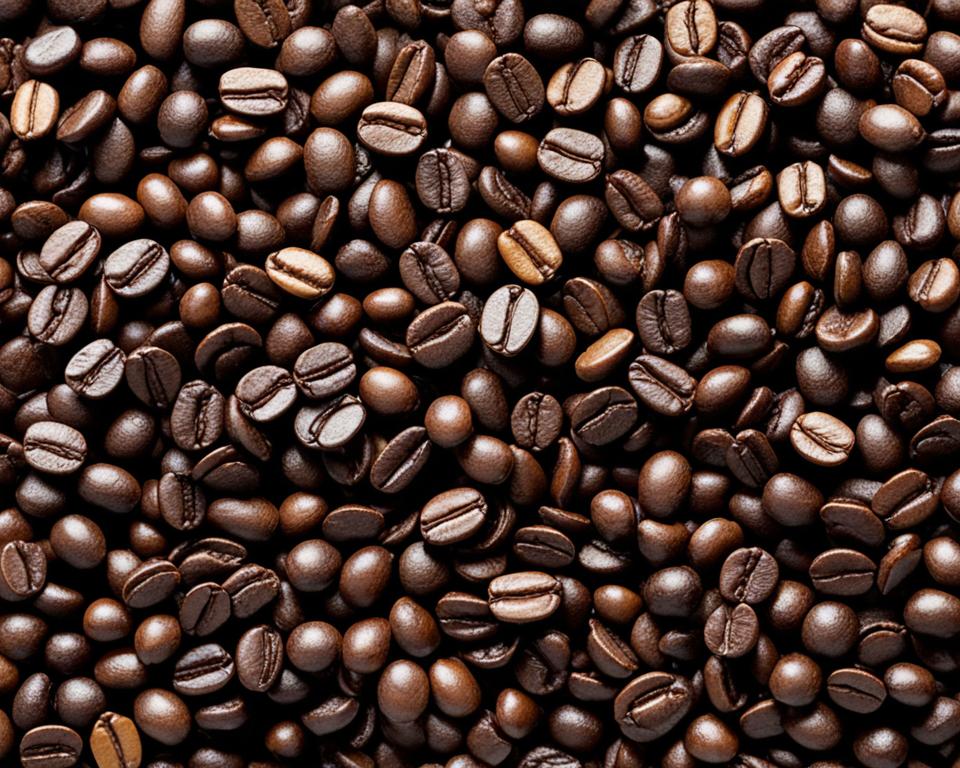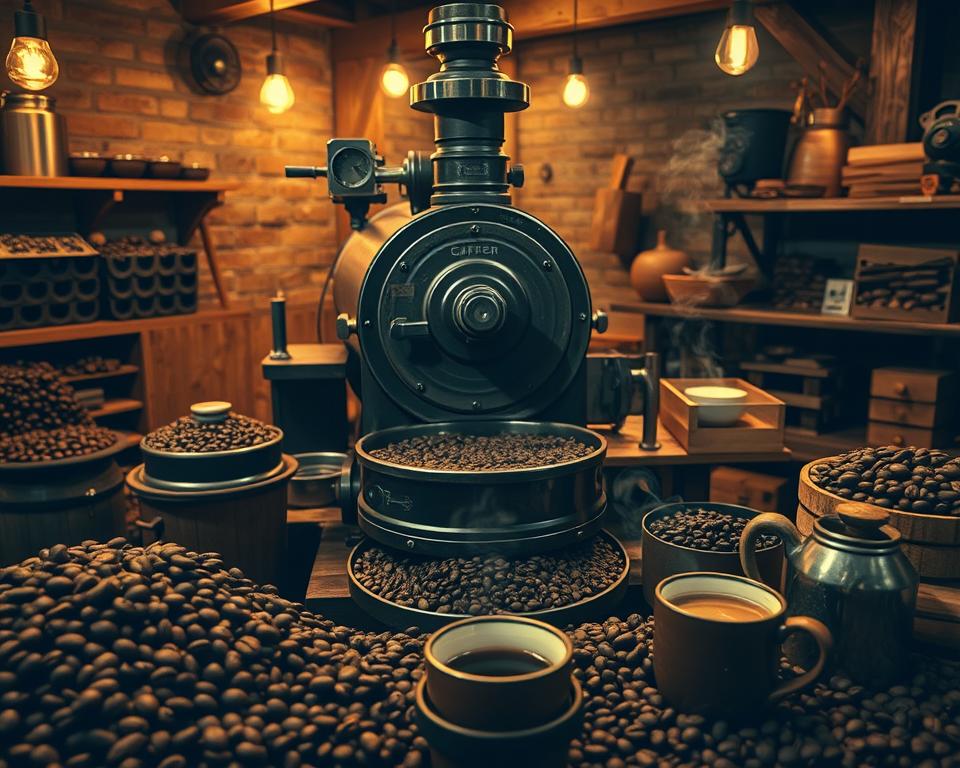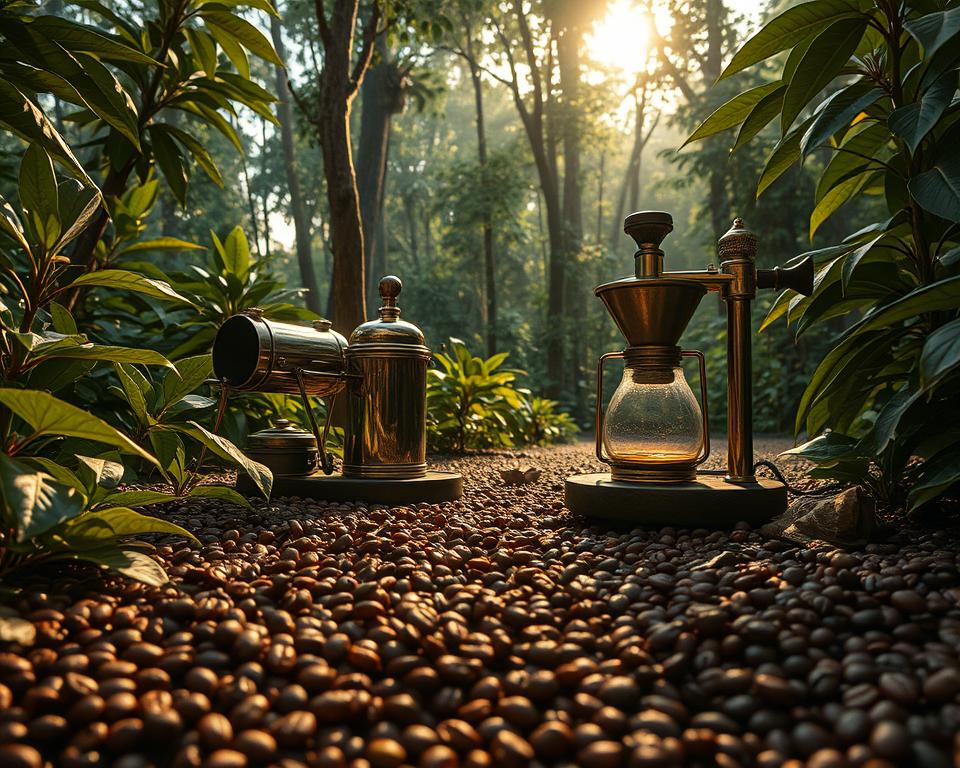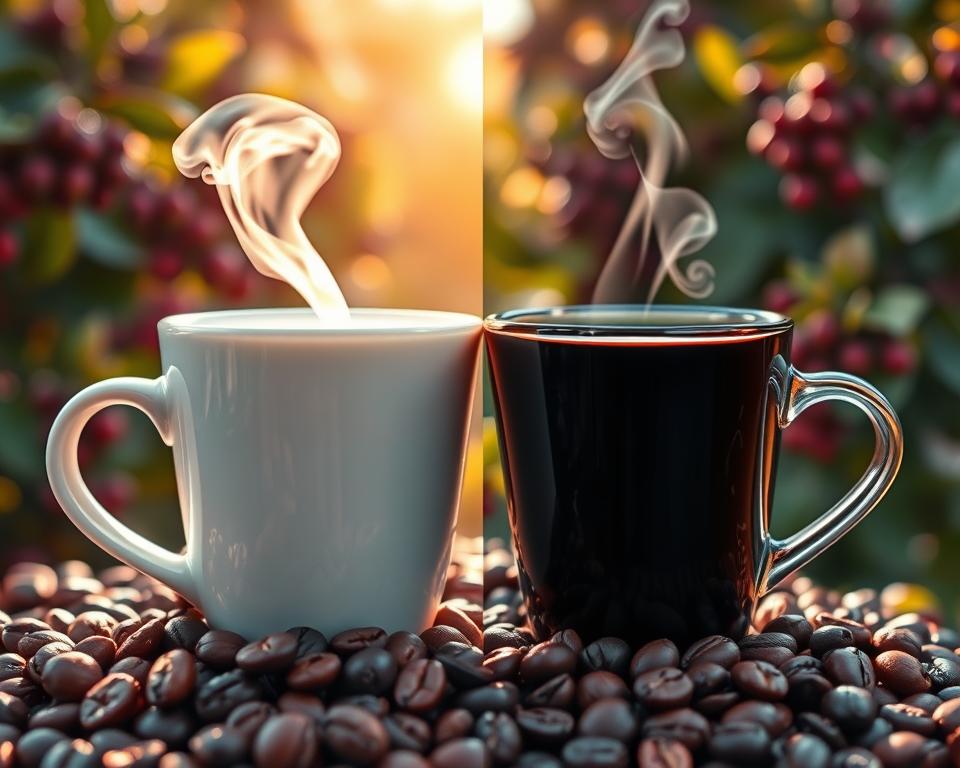Did you know that 64% of Americans drink coffee every day, showcasing the nation’s enduring love for the brew? Today, we’re diving into the intriguing world of coffee roasts, specifically the flavorful battle between French roasts and medium roasts. This flavor comparison promises an exciting exploration of the rich profiles these coffee beans offer.
When it comes to dark roast versus light roast, the conversation often zeroes in on French and medium roasts. French roast, known for its intense flavour and low acidity, stands in stark contrast to the balanced, medium-brown delight of medium roast.
Understanding these roast profiles can enhance your coffee brewing to match your perfect caffeine level. Let’s dive into these differences and discover why coffee connoisseurs relish these debates.
Introduction to Coffee Roasts
When it comes to coffee, roasting makes all the difference. The coffee roasting process transforms green coffee beans into the aromatic brown beans we adore.
But what exactly happens during roasting, and why does it matter so much for taste?
What is coffee roasting?
Coffee roasting is a precise heat process where green coffee beans are heated until they achieve the desired colour and flavour profile. As the beans roast, they undergo various chemical reactions, including the well-known Maillard reaction.
This particular reaction is crucial, as it creates the complex flavours and delightful aroma that define coffee.
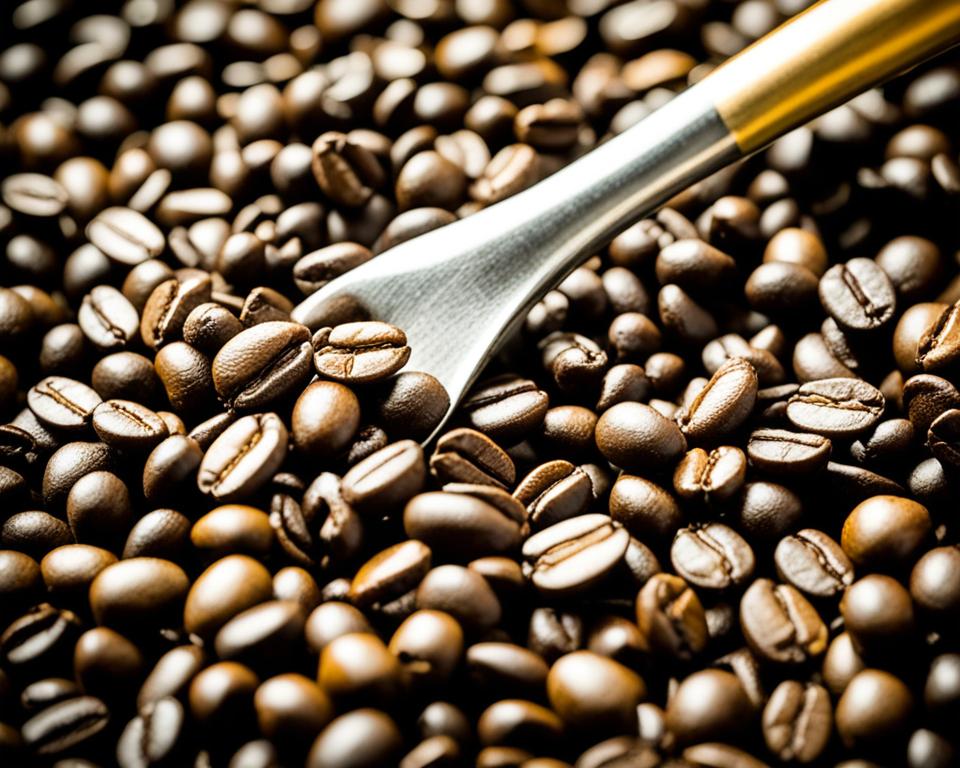
Different roasting times and temperatures impact the final flavor of the coffee. Light roasts preserve most of the beans’ original characteristics, while darker roasts develop deeper and more robust flavors.
This variety allows coffee enthusiasts to find their perfect cup.
Why Roasting Matters for Taste
The coffee roasting process doesn’t just change the colour of the beans; it’s essential for flavour development. When the beans are heated, moisture evaporates, causing the beans to expand.
These changes trigger multiple chemical reactions that contribute to the coffee’s aroma, body, and flavor. The Maillard reaction plays a key role in creating new flavour compounds that enhance taste.
Roasting is both an art and a science, with the perfect roast level unlocking a coffee bean’s potential. Each stage, from light to dark, brings out different nuances, ensuring a diverse and rich coffee experience.
So, every time you savour your cup, remember that the magic begins with the roast.
What is medium-roasted Roast Coffee?
When it comes to choosing the perfect coffee, medium-roasted coffee stands out for its balanced flavour and enjoyable complexity. Often referred to as American roast or city roast, this category appeals to many coffee lovers.
Flavor Profile of Medium Roast
Medium-roasted coffee combines the best of both worlds, offering a balanced flavour that’s neither too acidic nor too bitter. The medium-brown beans highlight the coffee’s natural oils, resulting in a subtle yet pronounced acidity.
When brewed correctly, fans of Starbucks Pike Place and Dunkin’ Original Blend appreciate the well-rounded taste.
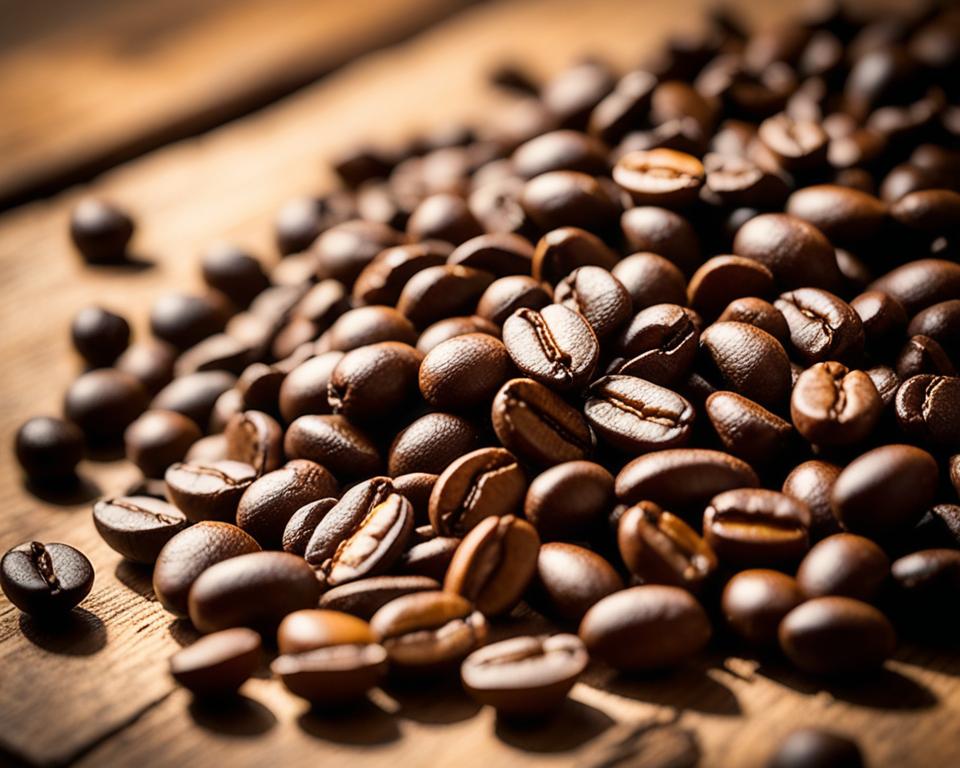
Brewing Tips for Medium Roast
To fully experience the richness of medium roast, using filtered water is key. Maintaining an optimal brewing temperature—between 195°F and 205°F—also brings out the best in these medium brown beans.
Whether you prefer a drip machine or a pour-over method, adjusting the grind size to medium ensures a complete extraction of flavours.
Popular Medium Roast Brands
Several brands have perfected medium-roasted coffee. Starbucks Pike Place is renowned for its balanced flavour and smooth finish, making it a staple in many homes.
Dunkin’ Original Blend, another favourite, offers a familiar and comforting taste that consistently satisfies. These brands demonstrate the wide appeal and versatility of medium-roasted coffee.
What is French Roast Coffee?
French roast coffee stands out with its dark roast, which gives it an intense flavour that’s simply unforgettable. I love the complexity it offers, from the smoky-sweet undertones to the low acidity that smooths the taste.
It’s a go-to choice when you want something bold and memorable.
Flavour Profile of French Roast
This type of dark roast is renowned for its robust flavor. The beans are roasted until they almost reach the point of burning, producing a charred, smoky taste that fans of strong coffee adore.
The intense flavour is coupled with a pleasingly low acidity, making every sip rich and smooth.
Brewing Tips for French Roast
To really bring out the best in French roast coffee, consider using a French press. It’s a method that retains all those nuanced flavors. Brewing espresso-based drinks with French roast can also elevate the smoky-sweet notes, delivering a powerful yet balanced cup.
Always use freshly ground beans for the most flavorful experience.
French Roast vs Medium Roast: Direct Comparison
When comparing French roast and medium roast, it’s clear that both have distinct characteristics that cater to different taste preferences. French roast, known for its bold and smoky flavour, sits at the darker end of the taste spectrum.
In contrast, medium roast offers a more balanced flavour profile with a lighter, often brighter taste. This disparity in flavour can be attributed to the varying roast temperatures used for each type; French roasts are subjected to higher heat, which intensifies their depth and complexity.
One notable difference lies in the caffeine content. Contrary to popular belief, French-roasted beans have slightly less caffeine compared to medium-roasted beans.
This is due to the extended roasting process, which burns off more caffeine. But many coffee aficionados still prefer French roast because of its rich taste and low acidity.
On the other hand, those who enjoy a moderate boost and a smoother body and texture often opt for medium roasts.
Another aspect to consider is the body and texture. French roast generally has a fuller body with a heavier mouthfeel, appealing to those looking for a robust experience. Conversely, medium roast provides a medium-bodied texture, making it versatile for various brewing methods.
The body and texture of your coffee can hugely influence your personal preference, especially if you savour every sip.
Finally, your choice may come down to personal preference. Whether you enjoy the intense and aromatic notes of a French roast or the subtle and balanced flavours of a medium roast, both types have something unique to offer.
Exploring these roasts is a rewarding journey that helps every coffee aficionado discover what they truly enjoy.
How I Fell in Love with Medium Roast
My personal journey with coffee exploration began with a single, unexpected encounter with medium-roasted coffee. It was a cold morning, and I had wandered into a small coffee shop downtown.
The comforting aroma that greeted me upon opening the door was instantly inviting.
I ordered a cup of their house medium roast, unsure of what to expect. As I took my first sip, the balanced flavour captivated my senses. It had the perfect mix of subtle acidity and a smooth finish, which was something I hadn’t experienced with other coffee roasts.
This delightful introduction soon turned into a morning ritual. I found myself returning to that coffee shop every day, eager to enjoy the consistent quality and delicious aroma of their medium roast.
The baristas, friendly and knowledgeable, often shared brewing tips, enhancing my understanding of homebrewing techniques.
Eventually, I decided to bring this experience into my home. Armed with a new appreciation for medium roasts, I began to explore various brands and brewing methods.
Whether using a French press or a drip coffee maker, the nuanced flavours of medium roast brought a satisfying start to my mornings.
This journey of discovering medium roast has been more than about finding a great cup of coffee. It’s been about the small moments of joy, connecting with baristas, and learning the art of homebrewing.
This perfect blend of aroma, flavour, and ritual has made medium roast an irreplaceable part of my daily life.
The Boldness of French Roast: My Experience
As someone who loves a rich, intense coffee experience, the French roast quickly became a favorite. Its robust flavours and deep, smoky notes offer a wake-up call that no other roast can match.
Coffee connoisseurs understand that French roast delivers a perfect balance of boldness and smoothness.
My Most Memorable French Roast Cup
One of my most memorable French roast moments happened at a small café in Seattle. I remember that first sip—it was like tasting coffee for the first time.
The intense coffee experience was unforgettable, filling my senses with rich, robust flavours and a hint of smokiness. I could taste the careful roasting process in every drop, making it a truly standout cup.
Cooking with French Roast: My Tips
French roast isn’t just fantastic in a mug—it has amazing culinary applications too. I’ve found that its robust flavours can significantly enhance recipes, adding depth and complexity.
For example, I love using French roast to make a coffee rub for steaks. The intense flavours complement the meat beautifully.
Another great use is in desserts. A splash of French roast can elevate classic chocolate cakes or brownies, making them richer and more aromatic. For the perfect pairing, try adding a French roast reduction to your sauces.
It’s an easy way to introduce a nuanced, coffee-infused flavour to savoury dishes. These recipe enhancements can turn a simple meal into a gourmet experience.
How Does French Roast Compare to Medium Roast in Terms of Flavor?
When you explore the world of french roast coffee, you’ll find its robust, bold flavor stands in stark contrast to the smoother, balanced profile of medium roast. The intense caramelization in french roast brings out deep, smoky notes, while medium roast retains more of the bean’s original character and acidity.
Picking Your Perfect Roast
Choosing the ideal coffee roast can feel like a journey of self-discovery, and it all starts with understanding your flavor preferences. Do you lean towards the bold, robust tastes or perhaps the smoother, more balanced notes? Establishing this will significantly enhance your home coffee experience.
The roast spectrum, ranging from light to dark, offers distinct taste profiles that cater to various tastes. Light roasts generally have a brighter acidity, while dark roasts provide a deeper, smokier flavor.
These differences can influence your purchasing decision more than you might think.
Consider the following when making a purchasing decision:
- Light roasts: are ideal for those who enjoy sweet, floral notes.
- Medium roasts: Perfect for a balanced flavor with a touch of acidity.
- Dark roasts: best for intense, bold flavors with low acidity.
By experimenting with various roasts, you can identify which one best satisfies your flavor preferences. Take note of how different roasts affect your home coffee experience. Whether you use a drip coffee maker, French press, or AeroPress, the roast can significantly impact the final cup’s taste.
So, what’s your next move? Dive into the diverse world of coffee and experiment with the roast spectrum to discover the roast that speaks to you. Happy brewing!
FAQ
What are the main differences between French roast and medium roast coffee?
The main differences lie in the roasting duration and flavour profile. French Roast is a dark roast with intense, smoky-sweet flavours and low acidity, while Medium Roast offers a balanced flavour with pronounced acidity and a medium brown colour.
How does the roasting process affect the caffeine level in coffee?
Contrary to common belief, the roasting level slightly impacts the caffeine content. Darker roasts like French Roast may have a marginally lower caffeine content than lighter roasts like Medium Roast, but the difference is minimal and often imperceptible.
Why is the Maillard reaction important in coffee roasting?
The Maillard reaction is a chemical reaction between amino acids and sugars that happens during roasting, giving coffee its complex flavours and rich aroma. This reaction plays a crucial role in developing the final taste profile of the coffee beans.
What are some popular medium-roasted coffee brands?
Popular medium-roasted coffee brands include Starbucks’ Pike Place and Dunkin’ Original Blend. These brands are known for their balanced flavours and medium-brown beans, making them favourites among coffee drinkers.
How should I brew medium-roasted coffee to best enjoy its flavours?
To fully enjoy the balanced flavours of medium-roasted coffee, use filtered water and maintain an optimal brewing temperature of 195–205 °F. Methods like drip brewing or using a coffee maker typically yield great results.
What brewing method works best for French-roasted coffee?
French press and espresso-based drinks are excellent for enhancing the bold flavours and low acidity of French roast coffee. This approach emphasises its intense, smoky-sweet undertones.
Can French roast coffee be used in cooking?
Yes, French roast can add robust flavours to culinary dishes. Use it in recipes that benefit from deep, intense coffee notes, such as sauces, desserts, and marinades, to provide an extra layer of complexity.
How do personal preferences influence the choice between French Roast and Medium Roast?
Personal preference is key in choosing between these roasts. If you prefer a bold, dark coffee with smoky flavours and low acidity, you might lean towards French Roast. If you enjoy a more balanced, acidic coffee with a medium body, then Medium Roast would be ideal.

